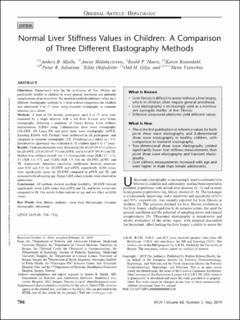Normal Liver Stiffness Values in Children - A Comparison of Three Different Elastography Methods
Mjelle, Anders Batman; Mulabecirovic, Anesa; Havre, Roald Flesland; Rosendahl, Karen; Juliusson, Petur Benedikt; Olafsdottir, Edda Jonina; Gilja, Odd Helge; Vesterhus, Mette
Peer reviewed, Journal article
Published version

Åpne
Permanent lenke
https://hdl.handle.net/1956/19864Utgivelsesdato
2019-05Metadata
Vis full innførselSamlinger
Originalversjon
https://doi.org/10.1097/mpg.0000000000002320Sammendrag
Objectives: Noninvasive tests for the evaluation of liver fibrosis are particularly helpful in children to avoid general anesthesia and potential complications of invasive tests. We aimed to establish reference values for 2 different elastography methods in a head-to-head comparison for children and adolescents 4 to 17 years, using transient elastography as common reference in a subset. Methods: A total of 243 healthy participants aged 4 to 17 years were examined by a single observer with a full liver B-mode scan before elastography, following a minimum of 3 hours fasting. Liver stiffness measurements (LSMs) using 2-dimensional shear wave elastography (2D-SWE, GE Logiq E9) and point shear wave elastography (pSWE, Samsung RS80A with Prestige) were performed in all participants, and compared to transient elastography (TE, FibroScan) in a subset (n = 87). Interobserver agreement was evaluated in 50 children aged 4 to 17 years. Results: Valid measurements were obtained in 242 of 243 (99.6%) subjects for 2D-SWE, 238 of 243 (97.9%) for pSWE, and in 83 of 87 (95.4%) for TE. Median liver stiffness overall was 3.3 (interquartile range [IQR] 2.7–4.3), 4.1 (IQR 3.6–4.7), and 4.1 kPa (IQR 3.5–4.6) for 2D-SWE, pSWE, and TE, respectively. Intraclass correlation coefficients between observers were 0.84 and 0.83 for 2D-SWE and pSWE, respectively. LSM values were significantly lower for 2D-SWE compared to pSWE and TE, and increased with advancing age. Higher LSM values in males were observed in adolescents. Conclusions: All methods showed excellent feasibility. 2D-SWE showed significantly lower LSM values than pSWE and TE, and lower failure rate compared to TE. Our results further indicate an age and sex effect on LSM values.
